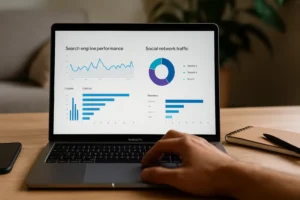In the digital world, measurement is as important as action. With thousands of visits, clicks, and conversions occurring every day, understanding user behavior becomes essential. And that's where Google Analytics comes in.
If you're wondering what Analytics is for, the answer is clear: it helps you make decisions based on real data. In this article, we explain, step by step, how this tool can become your best ally for analyzing, optimizing, and scaling your digital marketing strategies.
What is Analytics for and Why is it so Important?
Google Analytics doesn't just measure your website traffic. It goes much further: it allows you to understand your users, optimize your content, and evaluate the real impact of your campaigns. Those who understand Analytics can continuously and strategically improve their digital results.
1. In-depth Web Traffic Analysis
One of the pillars of Google Analytics is its ability to provide a complete view of how users arrive, navigate, and interact on your site. Understanding this allows you to identify opportunities and solve problems that are invisible to the naked eye.
What does Analytics do at this point?
- Origin of traffic: Identify whether users are coming from Google, social media, paid campaigns, emails, etc.
- Devices and browsers: Know whether your audience is browsing from mobile devices, tablets, or computers, and optimize the experience accordingly.
- Most viewed pages and navigation paths: Discover which content attracts the most attention and how users navigate your site.
This analysis helps answer key questions such as:
Am I attracting the right traffic? Is my content fulfilling its purpose? Where are my users dropping off?
2. Measuring Campaign Performance
Whether you invest in SEO or do digital advertising (international Google Ads, Meta Ads, etc.), you need to know what's working and what's not. This is where Google Analytics becomes even more valuable.
What is Analytics used for in campaign measurement?
- Conversion Tracking: Measure specific goals such as purchases, form submissions, calls, or clicks on strategic links.
- Evaluation by channel and campaign: Compare the performance of different traffic sources or ads.
- Conversion Funnel Analysis: Visualize every stage of the purchase or conversion process, and identify where users are falling through the cracks.
With this data, you can optimize your advertising investment, adjust messages, redesign landing pages, and make decisions based on evidence, not assumptions.
3. Optimizing the User Experience
Understanding Analytics also means improving how people experience your site. It's not enough to attract visitors; you have to ensure those visitors have a good experience.
What can you optimize with Google Analytics?
- Loading speed: Detects slow pages that can affect retention and SEO ranking.
- Performance per device: Make sure your site works properly on mobile devices, especially if most of your traffic comes from there.
- Behavior flow: Analyze when users leave your site, which pages generate the most bounce rates, and which ones drive conversions.
A good UX translates into more conversions and a better digital reputation. And Google Analytics gives you the clues to achieve it.
4. Detailed Knowledge of the Target Audience
One of the biggest benefits of using this tool is understanding who visits your website and how they interact. This allows you to create more effective and personalized strategies.
What is the use of Analytics in this regard?
- Demographic and geographic data: Discover the age, gender, and location of your users.
- Interests and affinities: Access information about their hobbies, tastes, and digital consumption habits.
- New vs. returning: Compare the behavior of first-time visitors with those who are already familiar with your brand.
All this information is vital to segment campaigns, define buyer personas and adjust your message based on your actual audience.
How to Implement Google Analytics in Your Digital Strategy
Now that you know what Analytics is for, it's time to learn how to set it up correctly to get useful and relevant data.
1. Effective Initial Configuration
Install Google Analytics It's not complicated, but doing it right is key to avoiding mistakes and collecting data from day one.
Basic steps:
- Create a Google Analytics account.
- Install the tracking code (or use Google Tag Manager).
- Connect your account to other tools (such as Search Console and Google Ads).
- Set up custom events and goals: for example, leads generated, WhatsApp clicks, newsletter subscriptions, etc.
2. Creating Custom Reports
Not all businesses need the same data. That's why one of the best features is the customization of reports and dashboards.
How is Analytics used here?
- Design dashboards with the most relevant KPIs for your business.
- Schedule automatic email reports for your team.
- Set up alerts for traffic spikes, performance drops, or major changes.
This allows you to make quick, contextual decisions, which is essential in changing digital environments.
3. Continuous Analysis and Constant Improvement
One of the principles of digital marketing is constant testing. Thanks to Google Analytics, you can evaluate results week by week and make proactive adjustments.
Benefits:
- Improvements based on data, not intuition.
- Rapid identification of errors or performance drops.
- Optimization of long-term strategies.
In short, Analytics isn't limited to observing the past, it's also useful for anticipating improvements for the future. Want to learn how to get the most out of your data? Discover step-by-step instructions on how to use this tool in our article: “How to Use Google Analytics?”
Success Stories: How Does the Correct Use of Analytics Transform Results?
At Agencia Roco, we've helped dozens of brands integrate analytics into their digital strategy, achieving measurable and sustainable results. Here are two real-life examples:
Fashion e-commerce
- Problem: high visits, but few sales.
- Solution: Funnel analysis with Google Analytics, redesign of key pages, and more targeted campaigns.
- Result: +25% in conversions in 6 months.
Travel agency
- Problem: low effectiveness in paid campaigns.
- Solution: integration between Google Ads and Analytics, new audience reports and remarketing.
- Result: +40% in engagement and return on ads.
These cases reflect what Analytics is used for in practice: to discover, tune, and scale.
Why is Analytics Essential and How Can It Benefit Your Business?
Google Analytics is much more than a statistics tool. It's a source of knowledge, a compass for your strategy, and a decision-making accelerator. Understanding Analytics and using it correctly can make a difference in your business's digital growth.
At Agencia RocoWe help you configure, interpret, and make the most of this tool so your data works for you. Whether you're just starting out or need to optimize your current strategy, we're ready to help.





